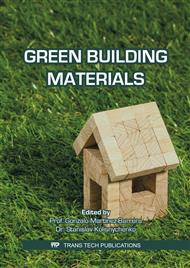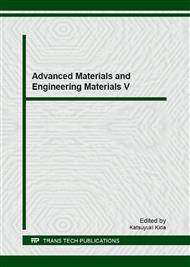[1]
H. Binici, O. Aksogan, M.N. Bodur, E. Akca, S. Kapur, Thermal isolation and mechanical properties of fibre reinforced mud bricks as wall materials, Construction and Building Materials, 21 (2007) 901-906.
DOI: 10.1016/j.conbuildmat.2005.11.004
Google Scholar
[2]
H. Binici, O. Aksogan, T. Shah, Investigation of fibre reinforced mud brick as a building material, Construction and Building Materials, 19 (2005) 313-318.
DOI: 10.1016/j.conbuildmat.2004.07.013
Google Scholar
[3]
I. Demir, An investigation on the production of construction brick with processed waste tea, Building and Environment, 41 (2006) 1274-1278.
DOI: 10.1016/j.buildenv.2005.05.004
Google Scholar
[4]
J. Khedari, B. Suttisonk, N. Pratinthong, J. Hirunlabh, New lightweight composite construction materials with low thermal conductivity, Cement and Concrete Composites, 23 (2001) 65-70.
DOI: 10.1016/s0958-9465(00)00072-x
Google Scholar
[5]
J. Khedari, P. Watsanasathaporn, J. Hirunlabh, Development of fibre-based soil–cement block with low thermal conductivity, Cement and Concrete Composites, 27 (2005) 111-116.
DOI: 10.1016/j.cemconcomp.2004.02.042
Google Scholar
[6]
M.A. Rahman, Properties of clay-sand-rice husk ash mixed bricks, International Journal of Cement Composites and Lightweight Concrete, 9 (1987) 105-108.
DOI: 10.1016/0262-5075(87)90026-1
Google Scholar
[7]
W. Namboonruang, R. Rawangkul, W. Yodsudjai, N. Suphadon, A Perspective on Properties of Low Thermal Lime - Hull Ash Adobe, Advanced science letters, 14 (2012) 336-339.
DOI: 10.1166/asl.2012.4103
Google Scholar
[8]
ASTM, Standard C140, Standard Test Methods for Sampling and Testing Concrete Masonry Units and Related Units, in, American Standard Testing and Materials (ASTM), West Conshohocken, PA, USA, (1996).
DOI: 10.1520/c0140_c0140m-14
Google Scholar
[9]
ASTM, Standard C67, Standard Test Methods for Sampling and Testing Brick and Structural Clay Tile, in, American Standard Testing and Materials (ASTM), West Conshohocken, PA, USA, (1996).
Google Scholar
[10]
ASTM, Standard C293, Standard Test Methods for Flexural Strength of Concrete(Using Simple Beam with Center-Point Loading), in, American Standard Testing and Materials (ASTM), West Conshohocken, PA, USA, (1996).
Google Scholar
[11]
ASTM, Standard C117, Standard Test Methods for Steady State Heat Flux Measurements and Thermal Transmission Properties by Means of the Guarded Hot-Plate Apparatus, in, American Standard Testing and Materials (ASTM), West Conshohocken, PA, USA, (1996).
DOI: 10.1520/c0177-13
Google Scholar
[12]
ASTM, Standard C90, Standard Specification for Loadbearing Concrete Masonry Units, in, American Standard Testing and Materials (ASTM), West Conshohocken, PA, USA, (1996).
Google Scholar
[13]
ASTM, Standard C129, Standard Specification for Nonloadbearing Concrete Masonry Units, in, American Standard Testing and Materials (ASTM), West Conshohocken, PA, USA, (1996).
Google Scholar
[14]
USEPA, Toxicity characteristics leaching procedure (TCLP), Method 1311, Cincinnati, (1982).
Google Scholar



